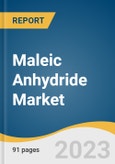The global maleic anhydride market size is expected to reach USD 5.86 billion by 2030,registering a CAGR of 4.2% over the forecast period, as per the new report. The industry growth is majorly driven by the rising demand for unsaturated polyester resins (UPR) in the global construction industry coupled with the flourishing automotive industry which is a major end use industry for the product market.
UPR possesses excellent resistance to chemicals, corrosion, abrasion, and heat, superior structural strength, excellent compressive strength, and high impact strength. Thus, it is widely used in the construction industry as concrete and sealant. In addition to the aforementioned properties, UPR is extensively used as a coating owing to its excellent aesthetic appeal. Moreover, as these composites can be pigmented without losing their structural properties, the demand for these composites is on the rise, and the trend is expected to continue over the forecast period.
According to Global Construction Perspectives and Oxford Economics, the global construction market is expected to reach USD 8 trillion by 2030, driven by the U.S., China, and India. Thus, the growth of the global construction industry, coupled with an increasing demand for UPR composites, coatings, and mortars, is expected to drive the growth of the UPR market over the predicted timeframe which in turn will drive the demand for maleic anhydride.
N-butane and benzene are the primary feedstock used to manufacture maleic anhydride. Globally, the prices of benzene and n-butane depend on the price trend of crude oil and naphtha. Volatility in crude oil prices has been the major reason for the high fluctuation in benzene prices. Crude oil pricing and downstream demand highly influence the global petroleum derivatives industry.
This product will be delivered within 1-3 business days.
UPR possesses excellent resistance to chemicals, corrosion, abrasion, and heat, superior structural strength, excellent compressive strength, and high impact strength. Thus, it is widely used in the construction industry as concrete and sealant. In addition to the aforementioned properties, UPR is extensively used as a coating owing to its excellent aesthetic appeal. Moreover, as these composites can be pigmented without losing their structural properties, the demand for these composites is on the rise, and the trend is expected to continue over the forecast period.
According to Global Construction Perspectives and Oxford Economics, the global construction market is expected to reach USD 8 trillion by 2030, driven by the U.S., China, and India. Thus, the growth of the global construction industry, coupled with an increasing demand for UPR composites, coatings, and mortars, is expected to drive the growth of the UPR market over the predicted timeframe which in turn will drive the demand for maleic anhydride.
N-butane and benzene are the primary feedstock used to manufacture maleic anhydride. Globally, the prices of benzene and n-butane depend on the price trend of crude oil and naphtha. Volatility in crude oil prices has been the major reason for the high fluctuation in benzene prices. Crude oil pricing and downstream demand highly influence the global petroleum derivatives industry.
Maleic Anhydride Market Report Highlights
- The global market is estimated to advance with a compounded annual growth rate (CAGR) of 4.2% from 2024 to 2030. This is attributed to the advancing application industries such as construction, automobiles, and pharmaceutical globally
- Unsaturated polyester resins in the application segment dominated the market with a revenue share of 50.1% in 2023. This growth is attributed to the growing marine and automotive activities, coupled with the increasing application scope of fiber-reinforced plastics in the construction sector
- Asia Pacific region dominated the global market with a revenue share of 52.1% in 2023. This growth is due to increasing construction activities in countries such as China, India, Japan, and South Korea. Rising demand for the product for application in new construction and remodeling of old structures is expected to fuel the growth of the regional market in the coming years
- The growing pharmaceuticals industry in the Asia Pacific region is also aiding the demand for maleic anhydride. According to the India Brand Equity Foundation, the Indian pharmaceuticals industry supplies over 50% of the global demand for different vaccines, making it the third-largest industry in terms of pharmaceutical production worldwide
- Moreover, the advancing construction industry in countries such as China, Japan, and India is further driving the demand for maleic anhydride in the region. According to the International Trade Administration, China is the world's largest construction market and is further anticipated to witness a growth of around 8.6% from 2023 to 2030
This product will be delivered within 1-3 business days.
Table of Contents
Chapter 1. Methodology and Scope
Chapter 2. Executive Summary
Chapter 3. Maleic Anhydride Market Variables, Trends & Scope
Chapter 4. Maleic Anhydride Market: Application Estimates & Trend Analysis
Chapter 5. Maleic Anhydride Market: Regional Estimates & Trend Analysis
Chapter 6. Maleic Anhydride Market - Competitive Landscape
List of Tables
List of Figures
Companies Mentioned
- Cepsa
- INEOS
- Huntsman International LLC
- Lanxess A.G.
- Mitsubishi Chemical Corporation
- MOL Hungarian Oil & Gas Plc
- Nippon Shokubai Co., Ltd.
- Polynt Group
- Thirumalai Chemicals Ltd.
- Jiangyin Shunfei
- Tianjin Bohai Chemicals.
Methodology

LOADING...
Table Information
| Report Attribute | Details |
|---|---|
| No. of Pages | 158 |
| Published | July 2024 |
| Forecast Period | 2023 - 2030 |
| Estimated Market Value ( USD | $ 4386.1 Million |
| Forecasted Market Value ( USD | $ 5863.1 Million |
| Compound Annual Growth Rate | 4.2% |
| Regions Covered | Global |
| No. of Companies Mentioned | 11 |









